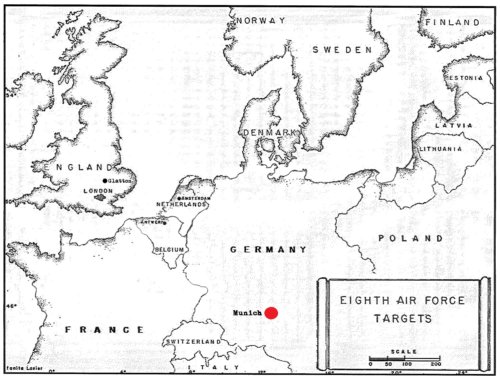TARGET: ALLACH AERO ENGINE WORKS
MUNICH, GERMANY
11 JULY, 1944

Munich, in addition to being the fourth largest city in Germany, had become a center of development for a jet propelled aircraft. Intelligence reports indicated planned early use of this plane against American heavy bomber formations. Experimental stations, factories for assembly and fuels, and operational fields, were located at nearby Leipheim, Schwabisch-Hall, Friedrichshafen and Lechfeld. The area also contained the parent BMW aero engine factory, Allach.
All of western Europe was overcast and the city presented the right kind of target to be located by PFF means. Twelve hundred heavy bombers were dispatched in a vast operation to hit this center of production. The 457th was directed to attack Allach if visual conditions existed, and the center of Munich if the expected ten-tenths undercast prevailed.
Thirty-six planes made up the lead and low boxes of the 94th B Combat Wing. Major Smith was Commander of the lead box and Captain Lady the low box. The Wing was second in the Division formation. Clouds interfered somewhat with the assembly and the routing over England.
En route to the English Coast, Lt. Jack W. Gazzales left wing tip caught fire and the crew began bailing out. The plane then blew up and the pilot was blown out of the plane. He parachuted safely to earth, together with five members of his crew. Three failed to survive. Read here Lt. Jack W. Gazzales account of what happened: Explosion-in-Mid-Air.pdf
The redisposition of antiaircraft guns north of Paris had closed the old route to southern Germany. The guns had to be avoided so the route to the target took the formation across the North Sea to the Scheldt Islands and thence due south to the west of Brussels, before a turn toward Munich was made at the northern French border. A complete undercast existed from there to Munich. The heavy concentration of single engine enemy fighters in the Paris region refused to be airborne and give battle.
The PFF equipment in both the A and B Wings malfunctioned, so a 360 degree turn was made in order to bring the formation in behind trailing wings for bombing on their more accurately placed smoke markers. Bomb results were unobserved. Only a moderate amount of flak came up through the dense undercast and it was thousands of feet from the formation. No plane received damage.
On the way home the enemy fighters still remained on the ground, although one thousand fifty heavy bombers had dropped 2,350 tons of bombs on Munich. Only twenty-four of the 1050 attacking force failed to return.
The crew of Lt Jack W. Gazzale was lost on this date.
